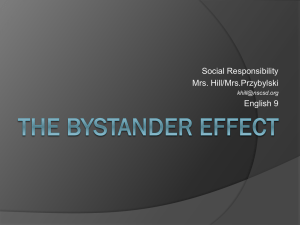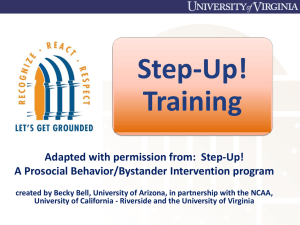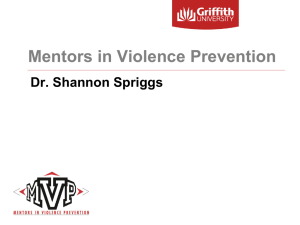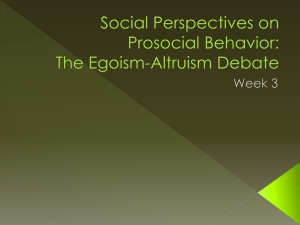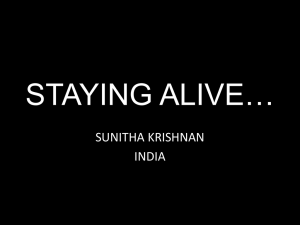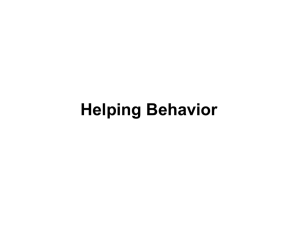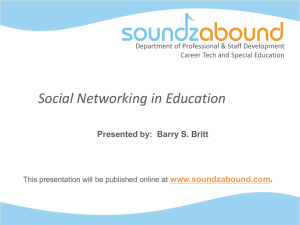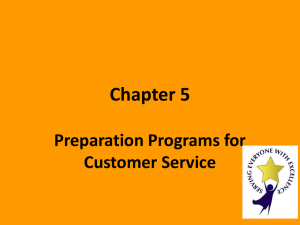PowerPoint slides - Counseling Center Village
advertisement
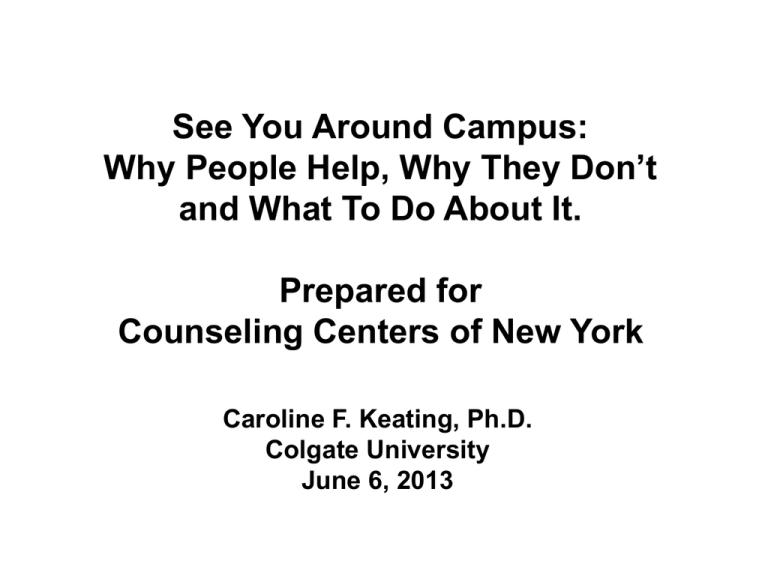
See You Around Campus: Why People Help, Why They Don’t and What To Do About It. Prepared for Counseling Centers of New York Caroline F. Keating, Ph.D. Colgate University June 6, 2013 A counselor, a social worker, and a social psychologist walk into a bar . . . Not really But if we did . . . Why People Help, Why They Don’t and What To Do About It Research Update I. “bystander-effect” Presence of others inhibits helping Others don’t have to be ‘present’** Can be a blessing - as well as a curse II. Identify motivational & situational factors III. Implications for designing programs Prosocial actions intended to benefit others Intervening in emergency situations Helping; altruism Empathy, sympathy, kindness Support, inclusion Sharing, charity, donating Antisocial actions intended to harm others Stigmatization, exclusion, rejection Maltreatment (inflicting punishment, distress) Aggressive behavior hostile or instrumental overt & relational Harmful Inaction – intended or otherwise icebreaker Nonconscious cues Shared and Nonshared Social Goals A 2012 meta-analysis of the social goals & aggression of children (18 & younger) revealed a “fit” The Big WE versus bystander effect Classic “Helping Behavior” Paradigms: Naïve participants alone OR presence of others - others may be naïve OR confederates (passive) “emergency” Results for the ‘smoke-filled room’ experiment Piliavin, Rodin, & Piliavin, (1969) Figure 1: Layout of adjacent and critical areas of subway car Conclusions from Early Bystander Studies • Bystanders inhibit helping – Diffusion of responsibility – Pluralistic ignorance – Evaluation apprehension • Implication for intervention programs based on increasing bystander responsiveness Recent re-analysis of the bystander effect -bystanders may be (some of) your best friends But only in the most dangerous situations – which few researchers have put to the test Disney ABC News: What Would You Do? Host: John Quinones WWYD Scenario: Abuse of Homeless People 3 key features related to college life: victim: outcast (stigmatized) “campus” emergency = hostile aggression Prediction (according to the bystander effect): See ABC’s WWYD on the abuse of homeless people http://www.youtube.com/watch?v=VWNQ5zbKw-Q elements elements Empathy/sympathy arousal Ease of escape Cost of not helping (guilt, shame) Ability, expertise Perceived threat Responsibility & duty Helper’s High pride, positive affect community humanization norms Group action/peer support disgust, anger Collective action more likely when • Bystanders are friends & danger is clearly evident • Psychological mechanisms: Adult men, alone or in groups, matched the face of a terrorist with a body, estimating muscularity & other traits. Fessler & Holbrook, 2013, Psyc Sci Sadly, a race bias persists Individual Whites are quicker to come to the aid of White than Black victims even in high emergency situations Individual Blacks = aid Blacks and Whites From: Kuntsman & Plant (2008). Racing to help: Racial bias in high emergency situations. JPSP, 95. Fiske (2011). Envy Up, Scorn Down: How Status Divides Us Can contact with ‘outgroup’ members prosocial behavior? • Koschate et al., (2012) studied workgroups in organizations • Assessed task and personal contacts • Assessed prosocial behavior & empathy directed toward outgroup generally directed toward individuals from outgroup Results Personal contact increased empathy & help for outgroup individuals Task contact increased expected rewards (& reduced costs) for helping & more help for the outgroup as a whole Applied to campus . . . WWYD Hazing Scenario: attitudes toward the victim See: http://www.youtube.com/watch?v=dMR7t_A55hk elements elements disgust Sympathy for victim? Moral outrage WWYD version of Jersey Shore . . . WWYD: The Drugged Drink Scenario Youtube links for WWYD parts I and II of drugged drink scenario http://www.youtube.com/watch?v=ue_fGd32Ewo http://www.youtube.com/watch?v=u716oysCtyI elements elements Anger Concern Relief Evaluation apprehension Established bond with abusive agent “America” Presence of likeminded others Attitude toward target Appearance of target Presence of like-minded others • Empowers • Blinds in 2 ways example: political attitudes (J. Keating, 2013) Example: enclaves on campus • Men express less willingness to aid a female sexual assault victim after being embedded in an all male group. • Women express less willingness to aid a female sexual assault victim after being singly embedded in a group of males; they express more willingness after being embedded in a group of females. The mere knowledge that similar others share your goal intensifies goal pursuit Two experiments: • UGs played a game independently; instructed to either Study 1: get points Study 2: avoid mistakes “Similar” others ‘chose’ the same color avatar (minimal group paradigm) Results: • UGs achieved more points (or avoided more mistakes) IF they knew that similar others shared their goal. • Knowing that others share your goal stimulates pursuit; no collaborative effort necessary! Putting the elements together Potential solutions: Easy to identify; challenging to implement The problem Potential solution • Foster the Big We • Shared social goals* -campus-wide projects Virginia Tech example • Identity salience/large group - Off-campus opportunities BOB, the bus • Promote liking among dissimilar individuals* -The Ba Potential solutions: Easy to identify; challenging to implement The problem Potential solutions • Foster SelfAwareness • Exposure to individuating experiences (reduce enclavement) (reinforce The Self) • Prime the right self • Reduce social comparison • Meditation/Mindfulness Potential solutions: Easy to identify; challenging to implement The problem Potential solutions • Make it easy to intervene • Create a culture of interveners - moral peers • Model intervention WWYD (use media power) Thank you! • Colgate’s counseling center • Tech support Wonderful audience – a hand for the volunteers!
